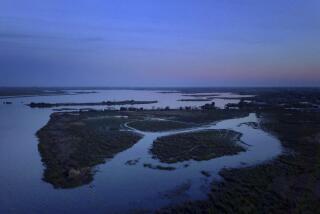Encroaching Development Threatens Freshwater Delta
- Share via
CLAY TOWNSHIP, Mich. — In the shadows of Detroit and its booming suburbs lies one of the largest freshwater deltas in North America, an oasis of marsh and prairie that also serves as a wildlife refuge.
The St. Clair Flats, spread over 80 square miles of U.S. and Canadian territory in the northeast corner of Lake St. Clair, range from dry fields of rare prairie grasses to deep canals. Tiny islands are surrounded by channels that flow to the lake, and migratory birds, fish, muskrats and other creatures thrive here, just 30 miles northeast of Detroit.
“It’s unbelievable, actually,” said Ernie Kafcas, a wildlife biologist with the Michigan Department of Natural Resources. “How are these animals surviving, especially ducks? Here we are, in a setting where millions of people are on their doorstep.”
But as housing developments creep nearer, concerns are rising that wildlife will be squeezed out. So state agencies and private groups are making plans to protect the flats area through land acquisition and a long-term management plan.
Longtime resident Ron Mynatt agrees that the flats need help. He has watched people flock to the area, craving its natural beauty and an escape from hectic urban life. Luxury home construction sites wedged between century-old waterfront cottages are testimony to its growing popularity.
“You need to tell those people over there to leave us alone and give the wetlands a break,” said Mynatt, 75, gesturing in the direction of Detroit.
“It’s nice to be able to walk down here. It’s so peaceful. You hear the chirping of the crickets and you don’t hear the traffic of the city.”
Last year, officials representing Lake St. Clair and the western Lake Erie watershed, which includes the flats, were awarded a $1-million grant under the North American Wetland Conservation Act.
The grant -- sought by the Great Lakes division of a nonprofit group called Ducks Unlimited -- will fund restoration of rare lake-plain prairies at Algonac State Park and the St. John’s Marsh Wildlife Area.
The grant will also give $600,000 to the natural resources department to buy undeveloped land. That’s considered the best way to prevent encroachment, and it will allow the state to expand the 2,500 acres in St. John’s Marsh that it now controls.
The two-year grant program, administered by the U.S. Fish and Wildlife Service, required the state and Ducks Unlimited to put together $3 million in matching funds in the form of cash, funds spent on watershed projects in the last two years and land acquisitions, according to David Brakhage, director of conservation programs for the Great Lakes division of Ducks Unlimited.
Brakhage said maintaining the flats is a critical part of protecting the waterfowl population of North America.
“It’s a natural funnel for waterfowl that migrate through this region,” he said. “Those habitats are extremely important for several species of ducks as a migratory stopover site.”
But dealing with the threats posed by humans is only part of the battle. Problems are also being caused by a natural intruder, a plant called phragmites.
Scientists don’t know for sure, but they suspect that the tall grass species is a hybrid of a native plant and a European variety that somehow found its way to the region.
The new plant has spread in recent years, killing off many native grasses that once thrived in the flats by blocking out the sun for plants closer to the ground. Environmental officials are looking for ways to control it.
They’ve tried herbicides and mowing. Scientists with the U.S. Army Corps of Engineers in Vicksburg, Miss., are working on a pathogen designed to kill just phragmites, Kafcas said.
For people who call the area home, nothing is more important than preserving the flats for future generations.
“We need to keep these areas,” Mynatt said. “I’m an old-timer. I don’t want to see them destroyed before I go.”
More to Read
Sign up for Essential California
The most important California stories and recommendations in your inbox every morning.
You may occasionally receive promotional content from the Los Angeles Times.













